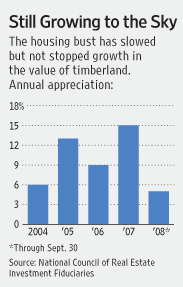haha
Give me a museum and I'll fill it. (Picasso) Give me a forum ...
I still have a decent chunk of Sallie Mae bonds OSM/ISM which despite all of the bad news still are sending me inflation adjusted checks every month.
I finally bought an Oil ETF which I think will act as an inflation hedge. Plus I like Ha Ha suggestion in another thread for timberland, in particular WY as good way of hedging against inflation.
I still have my ISM and OSM also. I think we will eventually get par at maturity, but about that I have low confidence.
For those interested in timber there is an excellent blog by a retired forester, woodlot owner and timber oriented stock investor named Brian Fiacco.
The Timberland Blog
Here is a recent excerpt:
"A real increase in future stumpage prices can and should be incorporated into the model if you think it is justified. U. S. Forest Service reports suggest that sawtimber stumpage prices have increased at a real rate of 2% a year over a very long period of time." On the other hand, "An analysis of southern pine stumpage prices by forest economist Jack Lutz reached the following conclusion:
“Our analysis indicates that southern pine sawtimber stumpage prices are mean-reverting, with a 50-year mean of $38.29/ton (based on LDAF data). Those prices have held to that mean through 50 years of timber supply and demand shocks and significant changes in timber harvesting and processing technology. That means we should not expect a significant increase in sawtimber stumpage prices in the near future. This supports the current practice of many timberland investors who are using 0% real appreciation rates in their timberland investment models.”"
So stumpage has increasd over a long time at a real rate somewhere between 0-2%. That doesn't sound so good, right? But remember, stumpage is just what the trees bring standing around at harvest time. Our per ton stumpage value may or may not be increasing in real terms, but it at least keeping track with inflation.
The lion's share of return comes from tree growth. Whether they are just hanging out drinking in the sun and the rain, or whether the tree farmer is intensively promoting their growth, they are growing and steadily increasing the tons of wood we will have available to sell at harvest time!
Weyerheuser in particular has not been this cheap for over 15 years. They definitely have issues, but they also have the trees. One thing I particularly like about Weyerheuser compared to some others is that they have high quality stands, in high quality growing areas like Pac NW and US SE. Some other well known outfits like Plum Creek REIT own good timberland in these areas, but also own a large amount of relative junk in New England and the Upper Midwest.
This is not a recommendation. If the last 8 months has proved anything, it is that anything can happen. And of course the mother of all depressions would definitely put a big crimp in stumpage prices for a good long while.
Other risks involve WY not being able to sell divisions that it wants to sell on its way to becomeing a REIT, and/or having trouble rolling over financing.
According to Mr. Fiacco, timber owning equities, be they be C corps like Weyerheuser or REITs like RYN, have lost much more value over the past year than timberland has lost in the fairly active markets on which it trades.
Ha

